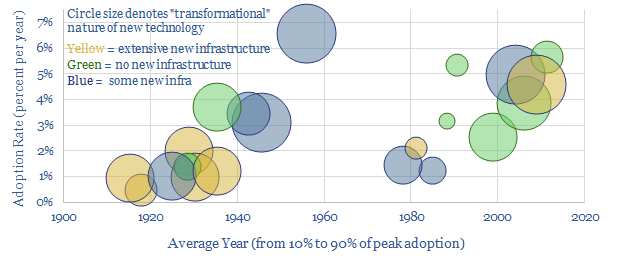It takes 15-100 years for a major new technology to ramp from 10% to 90% of its peak adoption rate. But what determines technology adoption rates? This 15-page note finds answers by evaluating 20 examples that changed the world from 1870 to 2020. We derive four rules of thumb, in order to quantify the pace at which different energy transition technologies will scale up.
Technology adoption rates matters both for meeting climate goals around the energy transition and for investors trying to forecast future market sizes, as argued on pages 2-3.
But how can we measure adoption rates? Our methodology is explained on pages 4-6, aggregating data on the adoption rates of twenty technologies that changed the world from 1870-2020.
Infrastructure requirements are the greatest determinant of a technology’s ascent, impacting adoption rates by a factor of 2-3x, as outlined on pages 7-8.
Transformational technologies that improve consumers’ lives are also adopted c2x faster than non-transformational ones, all else equal, as quantified on pages 9-10.
Adoption rates stall when economics are challenged, slowing down by as much as 5-7x, as measured on pages 10-12.
Technology adoption rates also appear to be speeding up, occurring 1% per year faster in recent decades compared with the early 20th century, as shown on page 13. This squares with a record pace of global patent filings and the way AI enables technology gains.
What does it mean for energy transition technologies? On pages 14-15, we use our insights to forecast the adoption rates for various energy transition technologies.
A general finding in our braoder energy transition research has been that new technologies take longer to reach maturity than might intuitively be expected (note here) and in our view, markets often over-value new technologies and under-value incumbents (note here).

